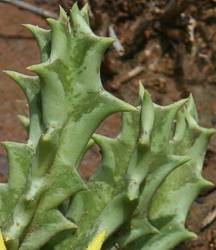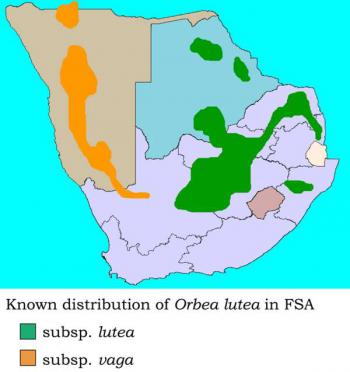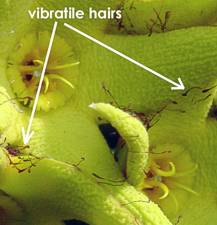Orbea lutea
Orbea lutea (N.E.Br.) Bruyns subsp. lutea
Family: Apocynaceae
Common names: yellow carrion flower (Eng.); geelaasblom, ghaap, gwaap, aasblom, kopseerblom, slang-gwaap (Afr.).
Introduction
This well-known succulent produces a clusters of up to 24 beautiful canary to mustard-yellow flowers which produce a pungent foul odour when in full bloom.

Description
Description
The yellow carrion flower is a succulent perennial without obvious leaves. The stems are usually crowded, 4-angled, 3-15 cm high and usually erect. When growing in shade the stems may become sprawling and will tend to be evenly green whereas those growing in full sun are mottled maroon to purple on a green background. The stems form prominent angles with acute teeth. The flowers are produced in clusters of sessile inflorescences consisting of 6-24 flowers, usually borne at the base of the stems. The flowers have a shallow tube with spreading lobes that taper off to long, slender segments. The lobes are fringed with dark maroon to purple, club-shaped vibratile hairs. Plants flower from December to April. The flowers are very variable in colour — in South Africa in various shades of yellow; in Botswana golden yellow to orange; and in Zimbabwe dark orange to almost maroon. The fruit is a single or paired, spindle-shaped follicle usually about 9 cm long.


Conservation Status
Status
This species is not threatened and was recently assessed (Raimondo et al.) as Least Concern (LC).
Distribution and habitat
Distribution description
The yellow carrion flower or kopseerblom is probably the most widespread species of the genus. In South Africa it occurs in Limpopo, North-West, Gauteng, Mpumalanga, Free State, KwaZulu-Natal and Northern Cape. Beyond the borders it is found in Botswana, Mozambique, Zimbabwe and further north to tropical Africa.
The plants grow in scrub, savanna (Acacia and mopane veld) and grassland at altitudes of 500-1500 m in full sun or semi-shade.

Derivation of name and historical aspects
History
The genus Orbea consists of about 56 species, mainly from Africa but some reaching the Arabian Peninsula. The genuss name Orbea is derived from the Latin word orbis, which refers to the central raised disc or annulus, found in the flowers of most species, and the epithet lutea which means yellow. The species was originally described by N.E. Brown in 1890 as Caralluma lutea, Larry Leach moved it to Orbeopsis in 1978 and eventually it was placed in Orbea by Bruyns in 2001.
Two subspecies are distinguished: the typical one and subsp. vaga. The latter is found along the lower Orange River and then northwards through most of Namibia to southern Angola. The typical subspecies is distinguished from vaga in having much thinner and longer corolla segments (3-5 times as long as broad compared to1.5-2.5 times as long as broad in vaga). The subspecies is also geographically separated. Subsp. vaga was originally collected by Hans Schinz and described as Stapelia vaga by N.E. Brown in 1895.
Ecology
Ecology
The complexity of the flower is closely associated with the process of pollination. Open flowers have a strong unpleasant odour reminiscent of rotting fish. This attracts large numbers of different flies from a distance to assist in the pollination. When the potential pollinators are closer to the flowers the vibratile hairs, which dangle in the slightest breeze, draw further attention by their movement. These mechanisms sometimes mislead the flies to such an extent that they lay their eggs on the flowers — probably believing that they may be a source of food for their hatched maggots.

After pollination, one or two follicles or 'fruit-horns' develop from a flower, with the tightly packed seeds inside. Each seed has a tuft of white hairs (called a coma) on the tip. When the follicles dry out and burst open, these tufts of hair dry and fluff out ensuring that the seeds become airborne and are dispersed. Young plants are found mostly under small bushes or shrubs, probably because this is where the coma gets stuck and the seeds are deposited. These microhabitats offer protection for seedlings to survive and establish.
The succulent nature of the plants enables them to become dormant during a part of the year, making use of stored food reserves. The stems, which contain chlorophyll, are responsible for the process of photosynthesis.
Uses
Use
The roots and young stems are eaten by some of the indigenous tribes in the area where it occurs.
Like most succulents it has potential as a garden plant, specifically in rockeries. Plants are, however, seldom sold by general nurseries. They can be obtained from growers who specialise in succulents, particularly stapeliads, and are usually grown by collectors from cuttings.

Growing Orbea lutea
Grow
The yellow carrion flower is mainly used as an ornamental plant, specifically suited for a rock garden. The green- and purple-mottled stems make an attractive ground cover when sterile. They can be used to enhance the area surrounding larger focal plants and will definitely attract attention when in full flower, if not by the beautiful flowers then by their odour.
Grow plants in full sun or light shade but with lots of light. If their situation in the garden is dry enough they can survive frost. It is best not to grow them outside their natural distribution range.
Cuttings are the best way to propagate the species, which can be done almost throughout the year. Leave the cuttings in a dry, shaded situation for at least a couple of days until the cut ends are completely dry. Place the cuttings on a well-drained, sandy medium consisting of equal parts of washed river sand, potting soil and topsoil. Place the cuttings on top of the soil mixture and put a stone on them to keep the stems upright. Roots will develop within a couple of weeks. Water sparingly until the roots are well developed — too much water at this stage can cause the cuttings to rot. After the cuttings have been properly established, water frequently in summer and keep them relatively dry in the colder months.
In nature, most of these plants are naturally sheltered from the hot rays of the sun by the shade of thickets and shrubs, but some can grow in full sun. Plants prefer early morning or late afternoon sun.
Fresh seed also germinates easily but is difficult to obtain. A ripening fruit can be taped with masking tape to prevent the seed from being dispersed when the follicle bursts open. Open the follicle as soon as it starts to split and harvest the seed. Sow them as soon as possible. Use a soil mix for seed of 2/3 sieved potting soil and 1/3 washed river sand. Lightly cover the seed with the mix. Seedlings germinate in about two weeks. Treat the seedlings for damping-off effects. Generally plants grow fast and most will flower within two to three years when grown from seed.
It is important for growers to establish from which region their plants originate and to adapt the watering regime accordingly. Plants need to go into a rest phase during the course of the year (in the summer rainfall areas it is during winter). Watering should be stopped at this time.
The most common pests are scale on the stems and mealy bugs on the roots. When stem-rot is observed, cut away the affected parts with a clean sharp knife. Various commercial pesticides and environmentally friendly concoctions can be used to fight pests. Mix in extra oleum with your treatment as many of the pests contain a waxy layer — the oleum helps the active ingredients to attach to the pests.
Combined geelaasblom and other stapeliads in a rockery can create an interesting feature in any garden. Grow this species with other larger succulents including Adenium, Pachypodium and species of Aloe.
References
- Barkhuizen, B.P. 1978. Succulents of southern Africa: with specific reference to the succulent families found in the Republic of South Africa and South West Africa. Purnell, Johannesburg.
- Bruyns, P.V. 2002. Monograph of Orbea and Ballyanthus (Apocynaceae-Asclepiadoideae-Ceropegieae). Systematic Botany Monographs 63: 1-195.
- Bruyns, P.V. 2005. Stapeliads of southern Africa and Madagascar, vol. I. Umdauss Press, Hatfield.
- Court, D. 2000. Succulent flora of southern Africa. A.A. Balkema, Rotterdam.
- Germishuizen, G. & Fabian, A. 1997. Wildflowers of northern South Africa. Fernwood Press, Vlaeberg.
- Gildenhuys, S. 2005. Southern African stapeliads for the beginner. Aloe 42: 24-27.
- Hardy, D. & Fabian, A. 1992. Succulents of the Transvaal. Southern Book Pubishers, Halfway House.
- Leistner, O.A. (ed.). 2000. Seeds plants of southern Africa: families and genera. Strelitzia 10. National Botanical Institute, Pretoria.
- Oliver, I.B. 1998. Grow succulents. Kirstenbosch Gardening Series. National Botanical Institute, Cape Town.
- Pole Evans, I.B. 1930. Caralluma lutea. The Flowering Plants of South Africa 10: t. 379.
- Pole Evans, I.B. 1936. Caralluma lutea. The Flowering Plants of South Africa 16: t. 621.
- Pooley, E. 2005. A field guide to wildflowers: KwaZulu-Natal and Eastern Region. Natal Flora Publications Trust, Durban.
- Raimondo, D., Von Staden, L., Foden, W., Victor, J.E., Helme, N.A., Turner, R.C., Kamundi, D.A. & Manyama, P.A. (eds). In prep. Interim Red Data List. South African National Biodiversity Institute, Pretoria. (www. sanbi.org).
- Smith, C.A. 1966. Common names of South African plants. Memoirs of the Botanical Survey of South Africa No. 35.
Credits
S.P. Bester
National Herbarium, Pretoria
January 2010
Plant Attributes:
Plant Type: Succulent
SA Distribution: Free State, Gauteng, KwaZulu-Natal, Limpopo, Mpumalanga, North West, Northern Cape
Soil type: Sandy, Loam
Flowering season: Late Summer
PH:
Flower colour: Yellow
Aspect: Full Sun, Morning Sun (Semi Shade), Afternoon Sun (Semi Shade)
Gardening skill: Easy
Special Features:
Horticultural zones









Rate this article
Article well written and informative
Rate this plant
Is this an interesting plant?
Login to add your Comment
Back to topNot registered yet? Click here to register.